The Turner Prize in 2018 is a miserable, tedious, poker-faced display
For god's sake bring back the visual allure – and perhaps even some of those colourful objects in two or three dimensions

Your support helps us to tell the story
This election is still a dead heat, according to most polls. In a fight with such wafer-thin margins, we need reporters on the ground talking to the people Trump and Harris are courting. Your support allows us to keep sending journalists to the story.
The Independent is trusted by 27 million Americans from across the entire political spectrum every month. Unlike many other quality news outlets, we choose not to lock you out of our reporting and analysis with paywalls. But quality journalism must still be paid for.
Help us keep bring these critical stories to light. Your support makes all the difference.
Last year the 33rd manifestation of the Turner Prize hit the buffers. By which I mean that it was shown at the Ferens Art Gallery in Hull, and Hull is the last stop on the line before you plunge into the North Sea. Hull did the show proud. The old cobbled streets were bouncing that Saturday night.
The Ferens itself had just been newly refurbished, and the entire institution seemed to pivot about the Turner – it has seldom felt quite so feted at its home base, Tate Britain, to which it has returned this year, even though the Stuckists seem to have lost interest in hating it so much these days.
Could that be because there’s too much else that’s truly appalling happening in the shrieking rat’s nest of contemporary art?
Some rather troubling things happened to the Turner last year. The rules were changed in two important respects. For the first time, it was decided that the prize would be awarded, at least in part, on the quality of the final show.
And the upper age limit of 50 (in place since 1991) would be entirely abolished – which means that the younger and the emerging were going to be put at a grievous disadvantage forever more. Why so? Because older artists have their maturity as artists to give them a lift – which can include the support of an established gallery and a long history of exhibition-making.
Last year age triumphed decisively – the winner was a 63-year-old professor of fine art, and the show an anthology of what she regarded as her best work from the 1980s onwards. Could the Turner be batty and youthfully edgy ever again?
There is no denying that most of the really eye-catching prize winners during the Turner’s best decade – Kapoor, Gormley, McQueen, Hirst – were either 30 or a little over.
This year only one artist is 30 years old, and two are in their forties. The fourth contender is a collective of filmmakers of variable ages called Forensic Architecture, founded by the architect Eyal Weizman, who is the 48-year-old professor of spatial and visual sultures at Goldsmiths, University of London.
Quite a lot has been written about the political nature of the contenders this year. All that really seems to matter to the judges are gender politics, discrimination of various kinds, human rights abuses and other right-on causes of pain to the comfortably settled reader.
What is most intriguing perhaps of all is that everything is film, film, film, film about the Turner this year. Painting doesn't get a look in. Perhaps this means that painting is outmoded all over again. Once upon a time, remember, painting was declared dead, and new media was all the rage – there was enough slow-motion video art going the rounds to die of boredom twice over in the 1990s.
Remember lying on a bean bag and snoring over Douglas Gordon’s version of Psycho at the Hayward Gallery, slowed down to be shown over 24 hours? This was the newest of the new art back then. Now we remember it better as a very effective way of stabbing a thriller to death in slow motion.
That was back in 2002. Now, at the very moment when figurative painting is enjoying a dramatic rebirth, the Turner has decided to celebrate a genre that perhaps looks a little outmoded these days. Still, it’s always good for the reputation of any institution such as the Tate to be politically right-on.
The show looks quite different from ever before this year. You enter through a large gallery dominated by a white table, surrounded by grey sofas, across which 43 books are strewn. Is this really an art show? Where is the promise of visual allure?
The staging makes it looks more like a seminar room with four offstage spaces for examples of all you’ve just been talking about. Those book titles could scarcely be more engagé and of-the-moment: Hollow Land – Israel’s Architecture of Occupation; Back to Black: Retelling Black Radicalism; The Extreme Centre – A Warning, by Tariq Ali.

Then you pop into each artist’s darkened booth to be taught your lessons in gender politics, identity, alienation, colonial violence. As an aid to punishment, only half of the booths have any seating.
Some of these films are very tedious indeed. And they are often tedious for a reason already cited above. Artists who make films often think it not only appropriate – all part of the artfulness of the art film perhaps – but entirely necessary to linger for a great deal of time over a single shot.
And this is an age when the editing of feature films has never been more skilfully snappy. Why do they test us in this way? Why do they push us to the point of extreme boredom and then beyond? Why, for example, does Luke Willis Thompson insist, in autoportrait, on showing us this dolorous, flickery, soundless image of Diamond Reynolds, the partner of Philando Castile, a black man murdered by police at a traffic stop in July 2016, for so long? And who is this young woman anyway? I ask several people in the room. No one knows. Why so difficult? Because this is one of several films on a loop.
Forensic Architecture is an international research agency that captures scenes of under-reported state violence, sorting state-speak from the truth. Their film here shows us a scene in the Negev desert, shot in January 2017.
The Israeli police have made a dawn raid on a Bedouin village to destroy homes. It’s all snatched, hectic stuff – the continuous blare of car horns, feverish shouting, running men, all captured in a mix of moving image, stills, superimpositions.
Charlotte Prodger has spent an entire year making a film shot on a iPhone called Bridgit. It lasts just 33 minutes. The film opens with a shot of a pair of grubby trainers on the end of a pair of legs, and to the accompaniment of a scatter of near inaudible words and a few drum-taps-cum-shuffles, before the narration – readings from her diaries and various queer books – chronicles her coming out in rural Scotland. The whole exercise – made possible by Creative Scotland – is dull and effortlessly self-indulgent in the extreme.
And pretty much the same thing can be said for the 93 long minutes of Naeem Mohaiemen’s Tripoli Cancelled, which is described as his very first “fiction film”. A man dressed as a pilot stands on the end of the wing of a plane in an abandoned airport, commiserating with himself. His few passengers are mannequins. Everything is broken, as Bob Dylan once sung – memorably though.
Oh dear. Oh dear. What a miserable, tedious, poker-faced display the Turner is this year! For god’s sake bring back the visual allure – and perhaps even some of those colourful objects in two or three dimensions. Cheer us all up for a change. We know that the world and all its misfortunes is too much with us. But it always has been.
Join our commenting forum
Join thought-provoking conversations, follow other Independent readers and see their replies
Comments